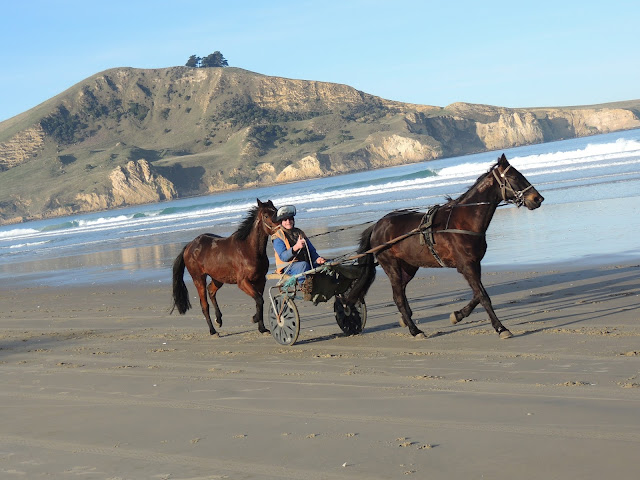
Here's our route today, a crystalline morning drive (click here if reading in email to view map).
Heading north toward Waikouaiti, Pacific Ocean shining in the distance. Every time we approach a new area of NZ I say to Art: I forgot how much I love this region!
We set up in the campground a few blocks from the beach and set out for a walk.
Well this looks like fun--harness racing on the beach.
Coats off in this warm sun. Feels good.
I was casting my eye far ahead to see if there was a little cafe around the turn of the beach and what should I spy but this fellow gallomphing out of the water. It's a NZ sea lion! I've been wanting to see a sea lion for weeks and assumed when I did it would be resting on the beach.
Art looks to the sand and says "there's another one," which to the casual eye appears to be a dark lump of wood or rock.
I remember the signs saying to stay 10 meters away--about 30 feet. We're probably double that and Art gets down to it with the zoom.
It's hard to tell if they're playing, fighting, or getting ready to copulate. Wrong season for the latter. Play, I think, based on the kabuki quality of their advances and retreats.
Also, after doing a bit of reseach I've learned the females are a blondish color.
Still, these two are mixing it up and it's absolutely thrilling to watch. And hear, since they're making big growls.
It's challenging to differentiate a NZ fur seal from a NZ sea lion, even after a pretty comprehensive review of the literature. Here's my rationale for calling our sighting a NZ sea lion. These animals also have an external ear flap (they're tiny, but can you see them?):
The New Zealand sea lion (Phocarctos hookeri - formerly known as the Hooker's sea lion) has a blunt nose and short whiskers.
There's much to be concerned about for sea lions. Read more on their history here.
Archaeological evidence suggests that New Zealand sea lions used to be found along the entire length of the coast from the northern end of the North Island down to Stewart Island and the subantarctic islands. Sea lion remains in excavations and historical records indicate that both Māori and European settlers hunted sea lions.
When the Auckland Islands were discovered in 1806, New Zealand sea lions were killed for their pelts for 24 years, until there were no longer enough sea lions left to support the trade. Many New Zealand sea lions were killed during this time but it is unknown exactly how many. Occasional killings continued until the late 1880s when the animals were protected by law.
In 1993, a female sea lion nicknamed 'Mum' had her pup on an Otago Peninsula beach. This was the first sea lion born on the mainland in over 100 years. Now, over 150 sea lions live on the mainland, and the Otago Peninsula averages 4 new pups born each year, almost all related to 'Mum'.
The extension of the New Zealand sea lion’s range by recolonisation of the mainland is essential to the long term survival of the species. However, it also means we will be increasingly sharing our beaches with sea lions, and we must take care not to disturb resting individuals and pups.
I could still be mistaking a fur seal for a sea lion, but don't think so. We stood and watched these two interact for more than half an hour. What an exciting day!
Here's a video on the endangered NZ sea lion (click here if reading in email to view vid).
As we walked back, I asked Art if when he was young he had the choice of visiting the Field Museum of Natural History or the Museum of Science and Industy which he chose. He rolled his eyes. Right. Art's birth father was a tool and die maker, his adopted father from childhood an industrial designer (who in fact designed exhibits for the Museum of Science and Industry). He comes by his proclivities via both nature and nurture.
I always chose the Field Museum. This has been a truly memorable week, with albatross and sea lions. On the return, one of the chariot people gives us the thumbs up. I love NZ.





















No comments:
Post a Comment